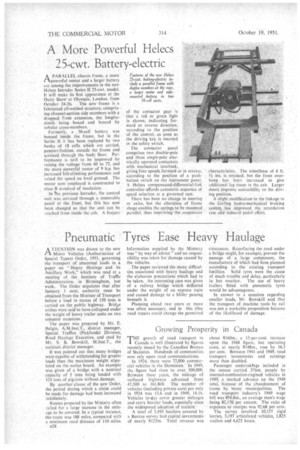Growing Prosperity in Canada
Page 62

If you've noticed an error in this article please click here to report it so we can fix it.
THE growth of road transport in Canada is well illustrated by figures recently issued by the Canadian Bureau of Statistics. Hundreds of communities now rely upon road communications.
In 1924, there were 72,000 commercial vehicles in the Dominion.' In 1949, the figure had risen to over 500,000. Between these years, the mileage of surfaced highways advanced from 47.500 to 161.800, The number of vehicles (including private cars) per mile in 1924 was 13.6 and in 1949, 14.16. Vehicles to-day cover greater mileages and carry heavier loads, especially since • the widespread adoption of trailers: A total of 3,493 hauliers covered by a Bureau survey had capital investments of nearly $125m. Total revenue was about $160m., a 15-per-cent. increase upon the 1948 figure, but operating costs, at nearly $148m., rose by 16.3 per cent. Between 1941 and 1949, road transport investments and earnings more than doubled.
Passenger undertaktngs included in the census carried 376m. people by internal-combustion-engined vehicles in 1949, a marked advance on the 1948 total, because of the abandonment of trams by 'many municipalities. The road transport industry's 1949 wage bill was $56.8m., an average man's wage being $2,170 per annum. The ratio of expenses to receipts was 92.68 per cent.
The survey involved 10,137 rigid lorries, 3,197 articulated vehicles, 1,825 trailers and 4,623 buses.




































































































